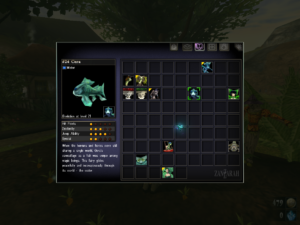Zanzarah: Types of Fairy
You might think that having all the combat creatures be fairies, on both the player’s side and the opponents’, would be kind of limiting. I remember thinking something similar when playing some Western-themed game (probably either the Lucasarts FPS Outlaws or Sierra’s Freddy Pharkas): what, it’s just cowboys? How much can you do with cowboys? But “cowboy” is just a category of person, and thus gives you the entire range of human personalities and physical types (extended, in both those games, by caricature). Similarly, Zanzarah applies “fairy” as a template on a fairly wide range of creatures.
 Since pretty much all the fairies do is fight, they don’t get much opportunity to express different personalities, except by grunting in pain or cheering their victory in different tones of voice. But there’s a very broad range of physical appearance. Child-like fairies and sexy fairies and fairies with animal heads, ones with chiseled musculature and ones that look like plush toys, ones with dragonfly wings or butterfly wings or bat wings or wings that look like leaves or flower petals. A few kinds don’t have wings at all, and fly by riding other creatures or mechanical vehicles. There are fairies that, contrary to expectation, are bulky and ungainly-looking, at least in comparison to the other fairies. In the extreme cases, you have fairies that don’t look like fairies per se, but like imps or gargoyles. There’s a skeletal fairy with the bones of batlike wings. There’s even one kind that’s a fish. I don’t mean it has fish-like features (although there are fairies like that too), I mean it’s indistinguishable from a fish. The color text excuses this as camouflage. Another type looks like a mushroom with eyes, and flies by flapping its cap up and down.
Since pretty much all the fairies do is fight, they don’t get much opportunity to express different personalities, except by grunting in pain or cheering their victory in different tones of voice. But there’s a very broad range of physical appearance. Child-like fairies and sexy fairies and fairies with animal heads, ones with chiseled musculature and ones that look like plush toys, ones with dragonfly wings or butterfly wings or bat wings or wings that look like leaves or flower petals. A few kinds don’t have wings at all, and fly by riding other creatures or mechanical vehicles. There are fairies that, contrary to expectation, are bulky and ungainly-looking, at least in comparison to the other fairies. In the extreme cases, you have fairies that don’t look like fairies per se, but like imps or gargoyles. There’s a skeletal fairy with the bones of batlike wings. There’s even one kind that’s a fish. I don’t mean it has fish-like features (although there are fairies like that too), I mean it’s indistinguishable from a fish. The color text excuses this as camouflage. Another type looks like a mushroom with eyes, and flies by flapping its cap up and down.
I suppose the fact that the designers felt the need to go so far beyond standard fairyhood is an indication that fairies actually don’t have the range needed for a game like this. All of which leads us to one question: why fairies? It seems like rather a big risk. The safe path for game design has always been to play to the power fantasies of boys. Arguably, RPG-style level advancement of the sort seen in Zanzarah is one way that this manifests. And fairies don’t fit into that very well. They’re pretty much the opposite of macho. Even if some of them look like demonic bodybuilders, you can’t help but remember that they’re tiny demonic bodybuilders. I can only assume that the developers were inspired by Pokémon‘s success in getting a cross-gender audience. After all, they took inspiration from Pokémon in just about every other aspect of the game.
But also, if fairies don’t have the required range… what does? The designers of Pokémon, in retrospect, had it easy: by creating an entirely new category of creature, they were free to populate it with whatever they felt like, including plants and ghosts and robots. Fairies are magical beings, and thus at least have some excuse to come in many and varied forms. Pretty much the only other thing I can think of that fits the bill is aliens.
 Comments(3)
Comments(3)